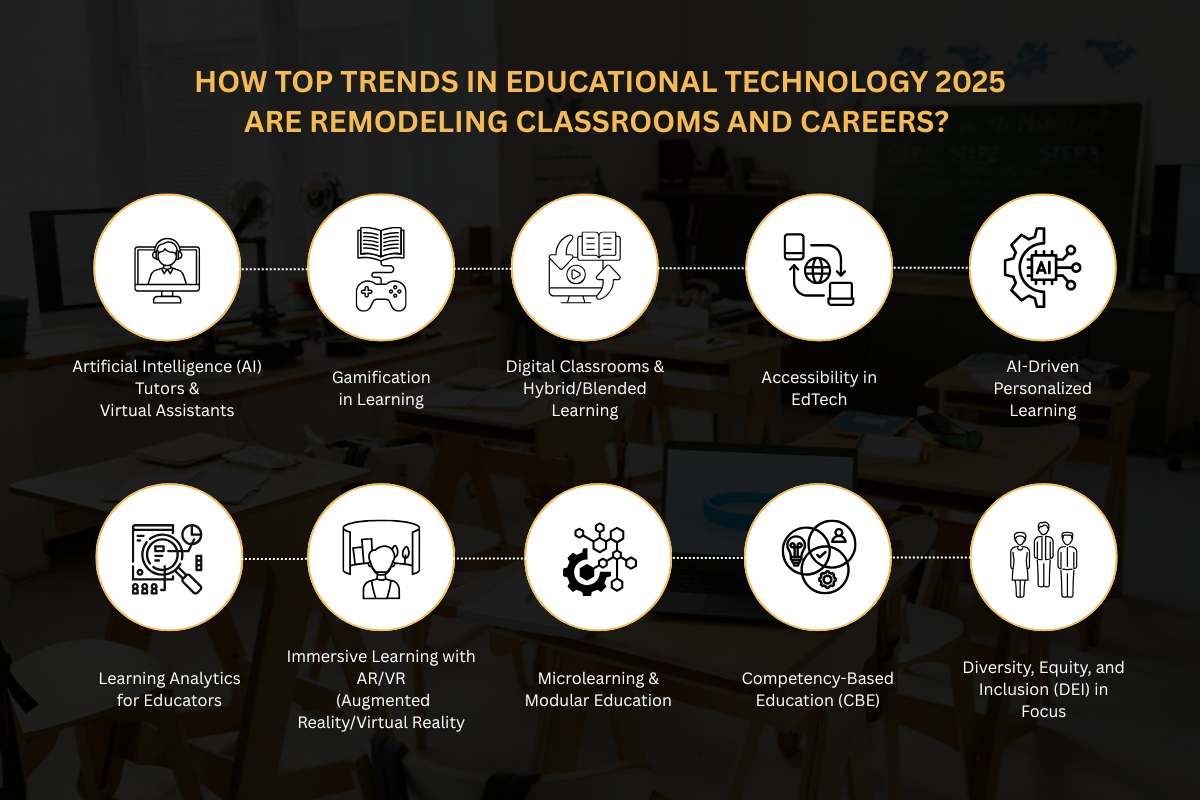What if the classroom you knew no longer existed, and in its place stood a smarter ecosystem that adapts to every learner, predicts your academic struggles before you face them, and prepares you for jobs that don’t even exist yet?
Welcome to the Top Trends in Educational Technology 2025
Driven by innovation and necessity, Top Trends in Educational Technology 2025 is now the foundation of modern learning. From AI-powered tutoring and gamified lessons to virtual reality field trips and competency-based learning models, the top trends in educational technology 2025 are reshaping how we teach, learn, and prepare for the future of work.
Whether you’re an educator striving to make your teaching more impactful, a university leader planning the next leap forward, or a lifelong learner eager to stay ahead, this guide is your roadmap to understanding the tools, trends, and transformations that are redefining education across the globe
.
Let’s dive into the
10 Top Trends in Educational Technology 2025 into launchpads for real-world success.

1. Artificial Intelligence (AI) Tutors & Virtual Assistants
Core Concept– AI tools providing on-demand, personalized academic support.
>. Functionality-
- Clarify complex subject matter.
- Answer frequently asked questions.
- Offer study tips and guidance.
- Provide real-time explanations with multimedia (visuals, voice).
>. Benefits for Educators/Trainers-
- Frees up instructor time from repetitive queries.
- Allows focus on deeper interactions and mentorship.
- Provides consistent, accessible support outside class hours.
>. University Perspective-
- Enhances student support services and academic success.
- Scales personalized assistance to large student bodies.
- Reduces faculty workload related to basic questions.
Example in Practice: A university student asks an AI bot to explain a complex economic theory, receiving an interactive explanation and follow-up questions.
2. Gamification in Learning
Core Concept- Applying game-design elements and principles to educational contexts.
> Functionality-
- Incorporates points, badges, leaderboards, and levels.
- Creates challenges, quests, and interactive simulations.
- Provides immediate feedback and progression tracking.
> Benefits for Educators/Trainers-
- Boosts student motivation and engagement.
- Encourages active participation and healthy competition.
- Makes learning more enjoyable and memorable.
> University Perspective-
- Improves course completion rates and sustained interest.
- Can be used to enhance specific modules or entire courses.
- Attracts and retains a generation accustomed to interactive experiences.
Example in Practice: A university course using a “point system” for completing assignments, with a leaderboard showing student progress, or a corporate training module designed as a series of quests with virtual rewards.
3. Digital Classrooms & Hybrid/Blended Learning
Core Concept- Integrating online and in-person instruction, making digital learning environments standard.
> Functionality-
- Utilizes Learning Management Systems (LMS) for content delivery, assignments.
- Incorporates video conferencing for live virtual sessions.
- Blends synchronous (live) and asynchronous (on-demand) activities.
> Benefits for Educators/Trainers-
- Offers flexibility in teaching methods and delivery.
- Provides tools for managing diverse learning materials and submissions.
- Supports the continuation of learning regardless of physical location.
> University Perspective-
- Expands global reach and accessibility for diverse student populations.
- Optimizes resource utilization (e.g., classroom space, faculty time).
- Prepares students for future work environments that often involve remote collaboration.
Example in Practice: A university course where lectures are recorded and available online, but students also meet weekly in person for discussions and project work.
4. Accessibility in EdTech
Core Concept- Designing educational technology to be usable by individuals with diverse abilities and disabilities.
> Functionality-
- Includes features like screen readers, closed captions, and audio descriptions.
- Offers customizable font sizes, color contrasts, and keyboard navigation.
- Ensures compatibility with various assistive technologies.
> Benefits for Educators/Trainers-
- Creates genuinely inclusive learning environments.
- Addresses diverse learning needs within a single platform.
- Ensures equitable access to educational resources for all students.
> University Perspective-
- Meets legal and ethical obligations for equitable access.
- Broadens potential student enrollment and diversity.
- Enhances the institution’s reputation for inclusivity.
Example in Practice: A university’s online course platform automatically generates accurate captions for all video lectures and offers transcripts for audio content.
5. AI-Driven Personalized Learning

Core Concept- Using AI algorithms to tailor learning content, pace, and presentation to individual student needs.
> Functionality-
- Analyzes student performance, engagement, and learning styles.
- Adapts content difficulty and sequence based on mastery.
- Identifies learning gaps and recommends specific resources.
> Benefits for Educators/Trainers-
- Enables highly targeted interventions and support.
- Transforms educators into facilitators and strategists.
- Maximizes learning efficiency for each student.
> University Perspective-
- Improves student retention and academic success rates.
- Provides data-driven insights into curriculum effectiveness.
- Supports scalable differentiated instruction across large cohorts.
Example in Practice: A math platform that gives a struggling student more practice problems on a specific concept they are weak in, while an advanced student moves on to more complex topics.
6. Learning Analytics for Educators
Core Concept- Utilizing data generated by EdTech platforms to gain insights into student progress and learning effectiveness.
> Functionality-
- Provides dashboards showing student engagement, performance, and completion rates.
- Identifies patterns of struggle or success.
- Tracks interaction with course materials and assessments.
> Benefits for Educators/Trainers-
- Enables proactive, data-informed intervention strategies.
- Helps pinpoint challenging topics or ineffective teaching methods.
- Supports evidence-based pedagogical adjustments.
> University Perspective-
- Informs curriculum design and resource allocation.
- Contributes to institutional effectiveness and strategic planning.
- Supports research into learning behaviors and outcomes.
Example in Practice: An educator reviewing a dashboard to see that a significant number of students struggled with a specific quiz question, prompting them to revisit that topic in class.
7. Immersive Learning with AR/VR (Augmented Reality/Virtual Reality)
Core Concept- Using AR/VR technologies to create highly interactive and experiential learning environments.
> Functionality-
- Allows virtual field trips to historical sites or inaccessible locations.
- Enables simulated experiments, dissections, or procedural training.
- Provides 3D models and interactive simulations for complex concepts.
> Benefits for Educators/Trainers-
- Offers unparalleled opportunities for hands-on practice in risk-free environments.
- Deepens comprehension through direct, sensory engagement.
- Makes abstract concepts tangible and memorable.
> University Perspective-
- Provides cutting-edge learning experiences, particularly in STEM and vocational fields.
- Reduces costs and logistical challenges associated with physical labs/trips.
- Enhances institutional reputation and attracts prospective students.
Example in Practice: Medical students practicing complex surgical procedures on a virtual patient in a VR environment before moving to real-world scenarios.It is the one of the best top trends in educational technology
8. Microlearning & Modular Education
Core Concept- Delivering educational content in small, focused, and easily digestible units.
> Functionality-
- Breaks down complex topics into short videos, interactive quizzes, or concise readings.
- Designed for on-demand access and completion in minutes.
- Modules can be standalone or combined to form larger courses.
> Benefits for Educators/Trainers-
- Caters to shorter attention spans and busy schedules.
- Facilitates quick upskilling or reskilling for specific needs.
- Offers flexibility for adult learners and corporate training.
> University Perspective-
- Supports continuous professional development and executive education.
- Enables the creation of digital badges and modular credentials.
- Increases accessibility and completion rates for lifelong learners.
Example in Practice: A corporate training program delivering a new software feature in a series of 5-minute video tutorials, each followed by a quick interactive quiz.
9. Competency-Based Education (CBE)
Core Concept- An educational model where progression is based on demonstrated mastery of skills and knowledge, not just time spent.
> Functionality-
- Uses adaptive assessments to gauge proficiency.
- Provides personalized pathways to achieve specific competencies.
- Tracks student skill acquisition and development over time.
> Benefits for Educators/Trainers-
- Ensures learners truly master concepts before moving on.
- Allows for flexible pacing that suits individual learning speeds.
- Focuses on practical, verifiable skills relevant to real-world application.
> University Perspective-
- Produces graduates with clearly defined and demonstrable skills.
- Aligns curriculum directly with industry needs and employer expectations.
- Can improve graduation rates by offering flexible progression.
Example in Practice: A university program where students complete a series of projects and portfolio pieces to demonstrate mastery of communication skills, rather than just passing a single exam. It is the one of the best top trends in educational technology
10. Diversity, Equity, and Inclusion (DEI) in Focus

Core Concept- Leveraging EdTech to create learning environments that are equitable, inclusive, and culturally responsive for all learners.
> Functionality-
- Develops culturally diverse and representative learning materials.
- Provides translation services and multilingual support.
- Uses AI to identify and mitigate bias in content or assessment algorithms.
> Benefits for Educators/Trainers-
- Fosters a sense of belonging for all students.
- Promotes critical thinking about diverse perspectives.
- Ensures fair and unbiased learning experiences.
> University Perspective-
- Supports institutional DEI goals and initiatives.
- Attracts a more diverse student body and faculty.
- Prepares graduates to thrive in diverse global workforces.
Example in Practice: An online history course including primary source documents and historical narratives from multiple cultural perspectives, supported by a platform offering immediate translation. It is the one of the best top trends in educational technology
Conclusion
The top trends in educational technology 2025 are a digital improvement of the education system. This invention came at a time of urgency, but has now become a crucial part of our education. For every educator to inspire, every trainer to aim for impact, and every university leader to chart a course, these trends offer approaches for deeper involvement and richer outcomes. The future of education is here, and it is vibrant with possibility.
Also Read :– 7 Best Ways EdTech Has Impacted Modern Education

